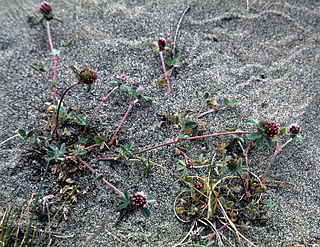
Trifolium albopurpureum is a species of clover known by the common name rancheria clover.
Trifolium andersonii is a species of clover known by the common names fiveleaf clover and Anderson's clover. It is native to the western United States, particularly the Great Basin and adjacent high mountain ranges, including the Sierra Nevada. It was named after Charles Lewis Anderson by Asa Gray.

Trifolium angustifolium is a species of clover known by the common names narrowleaf crimson clover, narrow clover and narrow-leaved clover.
Trifolium barbigerum is a species of clover known by the common name bearded clover.

Trifolium bifidum is a species of clover known by the common names notchleaf clover and pinole clover. It is native to the western United States from Washington to California, where it grows in many types of habitat. It is an annual herb spreading or growing erect in form. It is lightly hairy to hairless in texture. The leaves are made up of oval leaflets 1 to 2 centimeters long, usually with notches in the tips. The inflorescence is a head of flowers up to 1.5 centimeters wide. Each flower has a calyx of sepals that narrow to bristles covered in long hairs. The flower corolla is yellowish, pinkish, or purple and under a centimeter long. The flowers droop on the head as they age.
Trifolium bolanderi is a species of clover known by the common names Bolander's clover and parasol clover.
Trifolium buckwestiorum is a rare species of clover known by the common name Santa Cruz clover.

Trifolium ciliolatum is a species of clover known by the common name foothill clover. It is native to western North America from Washington to Baja California.

Trifolium depauperatum is a species of clover known by the common names cowbag clover, poverty clover, and balloon sack clover.

Trifolium eriocephalum is a species of clover known by the common name woollyhead clover or hairy head clover.

Trifolium howellii is a species of clover known by the common names canyon clover and Howell's clover. It is native to Oregon and California, where it grows in moist and shady habitat types, such as swamps and forest streambanks.
Trifolium lemmonii is a species of clover known by the common name Lemmon's clover.

Trifolium macraei is a species of clover known by the common names Chilean clover, double-head clover, and MacRae's clover. It has a disjunct distribution, occurring on the coastline of Oregon and California in the United States, as well as in South America. It grows in coastal habitat, such as sand dunes, and disturbed areas. It is an annual herb taking a decumbent or erect form. The leaves are made up of oval leaflets 1 to 2 centimeters in length. The inflorescence is usually made up of two oval or rounded heads of flowers each measuring up to 1.5 centimeters wide. Each flower has a calyx of sepals which taper into densely hairy bristles. The flower corolla is purple or bicolored with white or pink.

Trifolium macrocephalum is a species of clover known by the common name largehead clover or bighead clover native to the Great Basin region of the western United States.

Trifolium microcephalum is a species of clover known by the common names smallhead clover and small-headed clover.

Trifolium microdon is a species of clover known by the common name thimble clover. It is native to western North America from British Columbia to southern California, where it grows in many types of habitat, including disturbed areas. It is an annual herb taking a decumbent or erect form. It is coated in hairs. The leaves are made up of oval leaflets with notched or flat tips, each measuring up to 1.5 centimeters long. The inflorescence is a head of flowers borne in a deep bowl-like involucre of bracts that can nearly envelop the whole head. The flower corollas are white to pink and about half a centimeter long.

Trifolium monanthum is a species of clover known by the common name mountain carpet clover.

Trifolium obtusiflorum is a species of clover known by the common name clammy clover. It is native to California in the Peninsular, Transverse, Sierra Nevada, and the California Coast Ranges and Cascade Range into southwestern Oregon.

Trifolium oliganthum is a species of clover known by the common name fewflower clover. It is native to western coastal and montane North America from British Columbia to California, the Sierra Nevada, and to Baja California, where it occurs in many types of habitat.

Trifolium variegatum is a species of clover known by the common name whitetip clover. It is native to western North America from southern Alaska and British Columbia to Baja California, where it occurs in many types of habitat.














